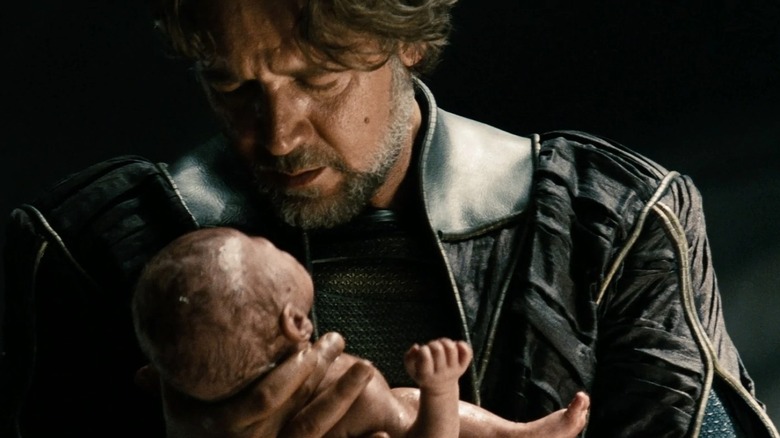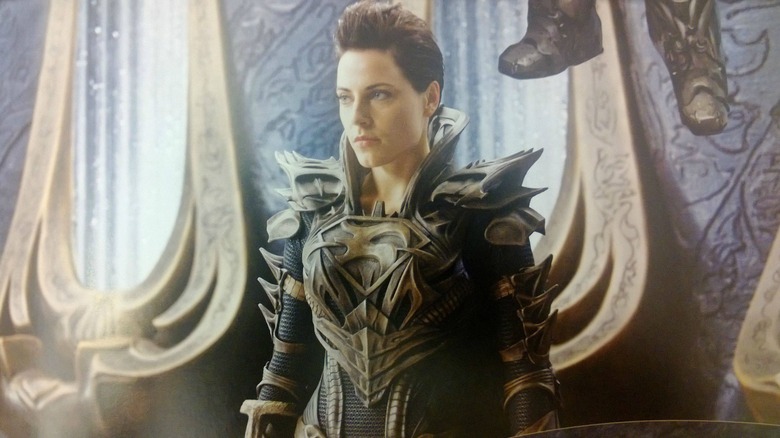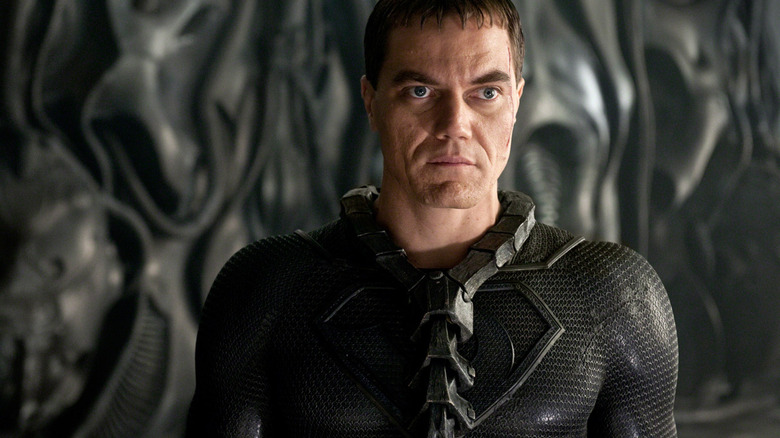Man Of Steel Hired A Professional Linguist To Add Authenticity To Kryptonian Language
Zack Snyder's 2013 film "Man of Steel" is a retelling of the Superman origin story. As with the 1978 Richard Donner film "Superman," "Man of Steel" begins on the distant planet of Krypton which is nearly due for its apocalyptic destruction. The scientist and scholar Jor-El (Russell Crowe) pleas with his planet's government to do something about it, warning that the end is nigh. They refuse him. At the same time, a military coup is underway at the hands of the violent General Zod (Michael Shannon). Things are not looking good for the planet. Jor-El, wanting to save his infant son from the planet's destruction, loads the baby Kal-El into a rocket and launches him toward an unknown planet called Earth. It's a pretty well-known piece of trivia that Superman creators Jerry Siegel and Joe Shuster loosely modeled their character's story after Moses in the book of Exodus. Instead of being sent down a river, however, Moses was launched into space.
In "Man of Steel," the Kryptonian technology rests weirdly between the metallic and the organic. Kryptonian clothes look like tight-knit chainmail, bearing a patterned texture so common in fantasy and superhero costume design. Kryptonian ship design involved rounded and organic shapes, featuring spare and clay-like interiors. When control panels are needed, spiky, metal tendrils extended from the walls and floor. None of it looks usable in any kind of practical, ergonomic way, allowing Kryptonian tech to emerge as truly alien. While the tone and actual narrative merits of "Man of steel" can certainly be debated, the costume and production designers clearly worked very hard.
The Kryptonian language
Rounding out the alien world's culture was Christine Schreyer, the linguist hired to create the Kryptonian language. Ever since J.R.R. Tolkien delved deep into the linguistics of his various fantasy species for the novel "The Fellowship of the Ring" back in 1954, many genre authors and filmmakers have sought to build entire, workable constructed languages — conlangs — into their imagined worlds. After Tolkien, the most famous conlang is probably Marc Okrand's Klingon language, created for "Star Trek."
In a 2013 interview with the website Kryptonian.info, Schreyer talked about how she constructed the Kryptonian language after meeting with Alex McDowell, the production designer on "Man of Steel," who had already completed a lot of the designs. Her idea was for the two of them to work together to construct an entire culture from the ground up, tying the architecture and costumes directly into their writing and speaking. She said:
"... I was joining my ideas to fit what was already developed. The first day on set, I was able to meet with Alex and hear the plot of the movie and more about the background of Krypton, which helped me decided on the use of the abugida (syllabic) writing system and SOV word structure. I did not read the script at any time although as I said I did know the plot of the movie via my meeting with Alex and the art department in August 2011."
SOV stands for subject-object-verb, a word structure used in Korean, Turkish, Japanese, Persian, and several other languages. In English, the equivalent word order might be "Fox, over the lazy dog, jumped."
Previous Kryptonians
The interviewer on Kryptonian.info knew the history of Superman, and was aware that earlier versions of the Kryptonian language had been built up for previous Superman stories. Schreyer revealed that she had only lightly researched the previous Kryptonians — some of which were based in Esperanto — but understood the mandate to make "Man of Steel" as different from previous Superman stories as possible. As such, she essentially started from scratch, trying to avoid too much outside influence from other language-makers. She said:
"When I received the original email asking me to come to the set and consult on how a created language might be used in 'Man of Steel,' I did do a bit of background research on what previous versions of Kryptonian (or Kryptonese) were available. However, as the motto of the reboot was to respect the canon, but to remember that this was a new telling of Superman's history Alex and his team (as well as the producers) wanted something that would fit the world they were creating."
Schreyer, of course, was familiar with the languages of Paul Frommer who constructed Na'Vi for "Avatar" and Barsoomain for "John Carter." But, in wanting Kryptonian to be unique, she intentionally looked away from what he had done in the past.
"Therefore, after I was committed to developing the new Kryptonian for Man of Steel I didn't look too much at the previous versions as I didn't want them to affect me subconsciously so that I might "copy" aspects of them. I know Paul Frommer has a similar way of working on his languages. He doesn't want other languages or other conlangers' work to affect his construction process."
Cree influences
Schreyer explained that the closest human analog to Kryptonian was Cree. In "Man of Steel," Superman explains that the "S" on his chest is in fact a letter from his home planet that translates to "hope." The concept of the Superman "S" being an alien symbol was invented for the 1978 "Superman" film. Schreyer took this as an indicator that the Kryptonian language is going to be very symbol-based, with singular characters built to mean entire multisyllabic words. In this regard, it was like Japanese. Schreyer said:
"I didn't particularly focus on any one language with the exception of Cree as an influence for the writing system. I also know a bit of Japanese so I suppose you could say my previous knowledge of Hiragana and Katakana from Japanese also influenced the writing system, but Cree is the one I know the best and was what I mentioned when showing syllabic writing to Alex and the team the first time."
She wanted to stress that Kryptonian, while infected by Japanese writing, wasn't meant to look or sound Japanese. She wanted to stay away from that sort of one-to-one analogue, and was keen to adhere close to the Cree language. She even snuck in a little wink for any Cree-speakers in the audience: Hello in Kryptonian is "si.tæn" which is "tansi" — the Cree word for "hello" — backwards.
Schreyer holds a PhD, and is an Associate Professor of Anthropology at the University of British Columbia. After "Man of Steel," she constructed the Altarian language for "Power Rangers" and Beama for the 2018 film "Alpha." Her most recent published paper, from 2021, is all about comparing ancient languages to conlangs. You can read it on the Royal Publishing Society website.



